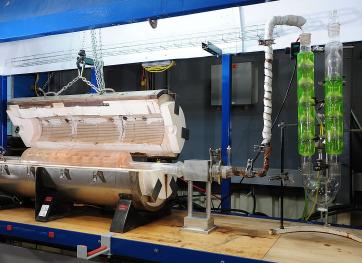Thermal Processing

Hazen Research’s Thermal Processing department assists in the development of new and existing thermal process flowsheets for engineering, mining, chemical, waste treatment, and various other clients worldwide. The corporate experience of Hazen Research covers the gamut of thermal processing applications.
Our staff includes experienced chemical engineers, metallurgical engineers, mechanical engineers, and process technicians whose expertise allows us to fully evaluate all essential process considerations including critical materials handling issues such as the feed, product recovery, and offgas handling systems.
We maintain an extensive collection of process equipment for programs ranging in scope from preliminary laboratory concept evaluation to pilot-scale demonstration plants leading to commercial plant design. Because we are not committed to any particular technology or affiliated with equipment vendors, Hazen is able to guarantee an unbiased evaluation of every application. Hazen is known for its thoroughness and the reliability of its results, and customers often come to Hazen’s Thermal Processing team to de-risk the scaleup of their thermal processes.
Examples of Thermal Processes at Hazen:
- Combustion
- Oxidation
- Reduction
- Drying
- Calcining
- Roasting
- Pyrolysis
- Activation
- Sulfating
- Purification
- Decontamination
- Mineralization
- Thermal Destruction
- Thermal Oxidation
- Volume Reduction
- Carbonation
- Carbonizing
- Denitration
- Decomposition
- Steam Reformation
Some of our recent projects involve:
- Roasting of double refractory high sulfide and carbonaceous gold ores
- Sulfation roasting of cobalt–copper–nickel concentrate
- Reduction roasting of nickel laterites
- Manganese carbonate calcination
- Zirconium sulfate calcination
- Selective chlorination of metals
- Antimony and arsenic fuming
- Combustion of coal, oil shale, refuse-derived fuel, and other fuels
- Combustion of municipal solid waste for energy recovery
- Treatment of mixed waste streams that contain high nitric acid concentrations from nuclear fuels reprocessing plants
- Cesium calcination
- Reduction roasting of manganese oxides to recover silver
- Carbon activation
- Graphite purification
- Rare earth sulfation
- Carbon pyrolysis and activation from various feedstocks
An incomplete list of our onsite thermal processing equipment follows:
Thermal Analytical Equipment
- Netzsch Simultaneous Thermal Analyzer
- Multiple Sized Muffle Furnaces
- Cold Flow Unit
Fluidized Beds
- 4 in. Fluidized-Bed Reactor
- 6 in. Fluidized-Bed Reactor (various configurations)
- 8 in. Fluidized-Bed Reactor (various configurations)
- 12 in. Fluidized-Bed Reactor
- 15 in. Refractory-Lined Fluidized-Bed Reactor
- 24 in. Refractory-Lined Fluidized-Bed Reactor
Rotary Kilns
- 2-7 in. High Temperature Furnace (various configurations and materials of construction)
- 4 in. Rotary Batch Kiln (quartz)
- 7 in. Rotary Batch Kiln (quartz)
- 7 in. Continuous Rotary Kiln
- 15 in. Direct-Fired Refractory-Lined Rotary Kiln
- 24 in. Indirectly Heated Rotary Kiln
- 24 in. Direct-Fired Refractory-Lined Rotary Kiln
- 60 in. Direct-Fired Refractory-Lined Sectional Kiln
Screw Kilns and Holo-Flites
- 2 in. Screw Kiln - Electric
- 5 in. Screw Kiln - Gas
- 8 in. Screw Kiln - Electric
- 3 in. Holo-Flite Processor
- 7 in. Holo-Flite Processor
Other Available Thermal Processing Equipment
- 24 in. Top Blown Rotary Converter
- 36 in. Multiple Hearth Furnace
- 63 in. Spray Dryer
- 36 kW Induction Furnace
- 3 ft3 Harper Box Furnace
Thermal processing technologies have retained their industrial prominence for several reasons. Many chemical reactions that are not thermodynamically feasible under ambient conditions occur spontaneously at elevated temperatures. Thermal processing also provides definite kinetic advantages, often-rendering reaction and transport rates so rapid that they are merely of academic importance. Other advantages include efficient separation and improved yield, inherently superior energy efficiency, and the relatively high throughput per unit volume of most thermal reactors. Critics decry thermal processing for air pollution emissions, but this argument is refuted by the ready availability of commercially proven gas collection and cleaning technologies.
Capabilities
Contact Hazen
Main (303) 279 4501
Fax (303) 278 1528
E-mail / Directions
Submit RFP
